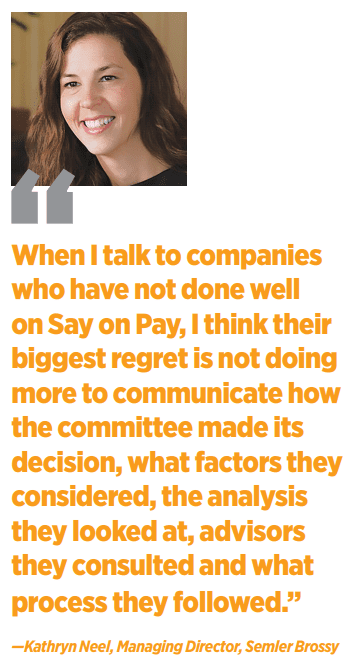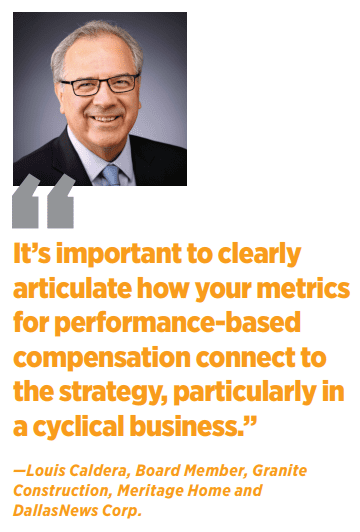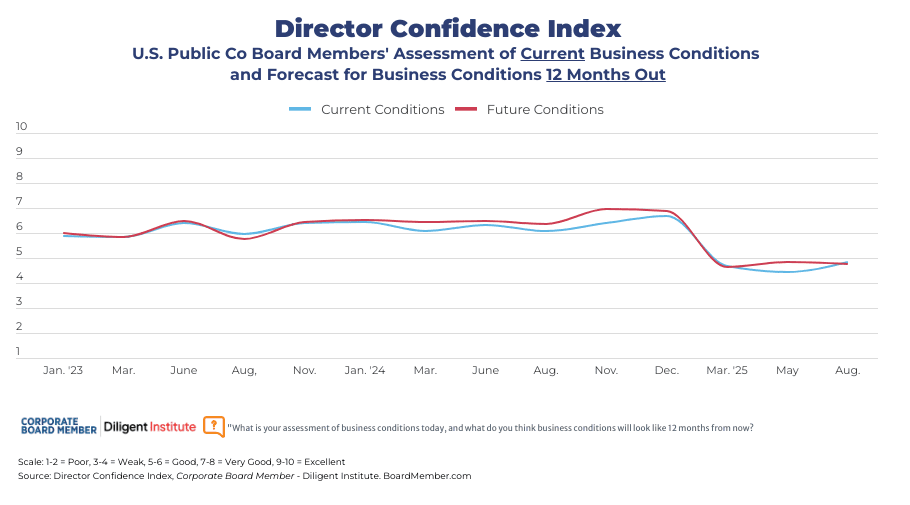Following a proxy season with the lowest Say on Pay failure rate since 2017, compensation committees could be forgiven for feeling relatively sanguine about the 2025 voting season. Yet investor scrutiny of compensation practices has been no less intense. A closer look at the 2024 proxy season underscores the heightened expectations investors and proxy advisors continue to have for companies across industries and size ranges with respect to pay-program design and decision-making.
One takeaway from examining the results for companies that struggled to get Say on Pay support this year is the need for more robust disclosure regarding compensation, particularly in scenarios that could be viewed by investors as deviating from best practices. Increasingly, today’s shareholders expect not only the ‘what’ but the ‘why’ and the ‘how’ behind compensation decisions, Kathryn Neel, managing director at Semler Brossy, told directors participating in a recent Corporate Board Member roundtable discussion held in partnership with Semler Brossy.
One-time awards, the perception of less-than-rigorous performance goals and use of discretion or qualitative assessments to adjust or determine incentive payouts were among the more common issues contributing to 2024’s Say on Pay failures. “There’s a much greater expectation of disclosure in those scenarios,” said Neel, who noted that compensation committees are sometimes so focused on executive compensation design and process that they spend too little time on disclosure. “When I talk to companies that have not done well on Say on Pay, their biggest regret is not having done more to communicate how the committee made its decision, what factors they considered, the analysis they looked at, the advisors they consulted and the process they followed. Even though the circumstances had changed or the goals were different than the prior year, they didn’t think to provide an explanation.”
Proxy Power
Conversely, companies that leverage the proxy statement to proactively address potential vulnerabilities can sometimes avoid investor ire. For example, when the railroad company CSX was taking compensation actions that it recognized could be controversial, its compensation committee was able to mollify investor concerns by working closely with the communications team to draft a comprehensive compensation disclosure statement, said Steve Halverson, board member and compensation committee chair at CSX.

“We’d been frustrated in the past, thinking that we were doing the right things for the right reasons, but it didn’t seem to resonate with proxy advisors or certain shareholders,” he explained. “So we took a primary role in developing a draft that got more into not just what we did, but why—what was the thinking? And it made a dramatic difference. We got quite positive results from our shareholders. Sometimes things you think are self-evident just need to be explained.”
His observation resonated with Louis Caldera, a board member at Granite Construction, Meritage Home and Dallas News Corp., who said the need for companies in cyclical industries to adjust performance benchmarks to adapt to changing market realities can be easily misunderstood by investors. “It’s important to clearly articulate how your metrics for performance-based compensation connect to the strategy, particularly in a cyclical business,” said Caldera, who chairs the compensation committee at Meritage. “If you’re setting benchmarks differently than you did in the past, it may look to someone who is not a close observer like you’re just lowering the bar for a maximum payout when there’s actually a very good, rational reason why you’re doing that.”
Ideally, large companies will not only take the time to create compelling proxy statement disclosures that clearly communicate how the company’s compensation design and decisions align with strategy, they will also devote resources to shareholder outreach, said Neel. “More and more, investors are expecting large-cap companies to engage in dedicated shareholder outreach, conversations that clearly connect the dots to justify compensation decisions.”

Robust disclosure coupled with shareholder outreach can also help stave off costly and time-consuming shareholder proposals. Common themes among shareholder proposals in the 2024 proxy season included calls for clawback provisions, stock retention requirements and stock ownership guidelines—in some cases placing proposals up for vote at companies that had already adopted such measures. “The rebuttals by some companies were basically, ‘We already have this practice in place,’” said Neel. “In at least a few of these instances it turned out that the disclosure wasn’t super clear, which represents an opportunity, because it’s a nuisance for companies to receive a shareholder proposal and have to go through that process.” Heading into the 2025 proxy season, a look back at 2024 proposals may be a useful exercise for compensation committees, which can then look for and fill any gaps in disclosure.
While a powerful tool, clear communications can only go so far, noted several roundtable participants, who pointed out that compensation committees must sometimes choose between doing what’s right for the business and what will pass muster with proxy advisors and shareholders.
Even with justification, some actions taken will always garner a no vote from proxy firms that take a no-exceptions stance on some Say on Pay decisions— which is all the more reason for robust communications to stakeholders. “With these singular actions that tend to be scrutinized, we all spend a lot of time thinking about advisory firms,” said Gary Collar, a board member at Hillenbrand and Hyster-Yale. “But there is the opportunity, despite whatever Glass Lewis or ISS has to say, to talk with the actual shareholders involved, to make sure that our shareholders understand where we’re coming from with the decisions that are taken. At the end of the day, what really matters is that relationship you have with your shareholders, the guys who are going to make a difference in that vote.”
Decision Drivers
While the focus of compensation design and decision-making should always be developing practices that drive value creation over the long term, that philosophy is not always embraced by proxy firms and investors, noted several discussion participants. “We all recognize that the bulk of executive compensation comes from long-term earnings, growth and share price increase, not from the annual incentive plan,” said Raj Gupta, a former board member at Delphi, Aptiv, HP and Tyco, who questioned compensation programs that heavily weight business unit performance. “Unfortunately, a lot of the pressure on quarterly earnings and other things are driven by the short term…. What companies need to think about with compensation is how to have business-unit performance and leaders’ performance driven more by corporate performance, as opposed to the performance of their business unit.”

“Long-term value is our job,” agreed Collar, who added that a lack of long-term focus by shareholders can serve to undermine retention efforts. “When you have a bad year and are trying to balance what you need to do to retain your team, you get visits from shareholders who don’t always have the long term in mind.” If a compensation committee views exercising discretion to adjust bonus payouts as essential for retention purposes, the company may need to be willing to risk a no Say on Pay vote.
Several directors also view the recent pushback from investors on compensation programs that tie incentive pay to diversity and inclusion metrics as myopic. “We are going to reach a point within the next decade or two where the majority of people living in America will be of color—and organizations need to recognize who is going to make their products, who is going to sell them and who is going to buy them,” said Herman Bulls, a board member at USAA, Host Hotels, Fluence Energy and Comfort Systems. “It’s kind of like a frog in water—what you do on it isn’t going to make a difference today, next week, or next month, but as you look at what’s going to happen over the next few years, organizations that don’t have that foundation of having a diverse leadership team will not be as successful.”
Like many companies, CSX plans to continue its practice of including such metrics in its compensation program. “We’re not pulling back one bit,” said Halverson, who acknowledges that the decision may put the company at risk of litigation. “We have a 180-year history that is, candidly, not women-friendly and not racially friendly, so we felt not pulling back was a matter of strategic importance. That was an easy conversation. A harder conversation was, ‘How much should we talk about it?’ We concluded that we had to talk about it the same way we always have, because muting our voice would be sending the wrong signal to our team.”
Decisions around CEO compensation are another area that can be controversial. Caldera cited the Delaware Court of Chancery’s decision to rescind Elon Musk’s pay package, in which Musk’s friendships and business relationships with Tesla’s outside directors played a role in making the plan subject to review, as an example. “Directors were reminded that if you don’t meet the independence test, you lose the value of the business judgment rule,” he said, noting that while Tesla shareholders ultimately restored the package, the theme behind the tussle that ensued is an extension of the long-term value dilemma. “What divided shareholders on that package goes back to the conversation that compensation is about creating long-termshareholder value, but it’s also about what share of that shareholder value is going to the CEO, to the C-Suite, versus being returned to shareholders in some form.”
Proactive Proxy Statements

Heading into the coming proxy season armed with the knowledge that today’s shareholders are looking for more information on process and rationale, boards can prepare by ensuring that disclosures clearly articulate pay-program design and decisions made throughout the year. In some cases, that may entail overseeing the drafting of proxy statement compensation disclosures more closely. “Most of the time, the person writing the disclosure sits in the legal department and was not in the room when these decisions were made,” said Neel. “You don’t typically have the finance person writing about why the performance metrics were changed, or the CHRO writing about the processes undertaken to evaluate the retentive value of compensation for a key executive.”
To ensure clear and sufficient disclosures, compensation committees may need to task management with highlighting areas of the proxy most likely to be scrutinized and to discuss how to effectively communicate the decision-making rationale behind those compensation actions. That process can also be a useful exercise for boards, which can then determine if shareholder outreach is warranted, and, if so, prepare to proactively engage with investors.
“There may be situations in which a ‘no’ vote is unavoidable, but providing a strong explanation for, say, why a metric was removed from an incentive program or a special award was given can, in some cases, help shareholders understand and accept the decision,” said Neel. “There’s no silver-bullet approach that will [guarantee] support on Say on Pay. However, the more justification you provide—the more compelling a case you make, the more ammunition you give to folks who actually vote the shares not to fall in line with an ISS or Glass Lewis recommendation—the better, because they need something to point to in order to justify making that decision. That’s something to keep in mind as you approach the 2025 proxy season.”






